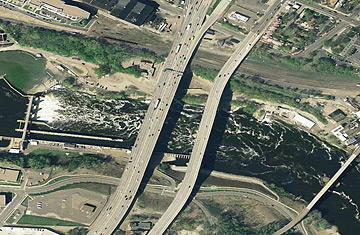
I-35W Mississippi River bridge before collapse
The forensic engineers have not yet determined why the bridge collapsed in Minneapolis, but the congressional porkers have made their diagnosis: Lack of money. Republican Congressman Don Young of Alaska complained that if President Bush hadn't forced deep cuts in his $375 billion transportation bill, America's infrastructure wouldn't be rotting so rapidly. "I don't do this often when I say I told you so," he said.
Maybe we do need new transportation resources. But first we need new transportation priorities. Congress has to stop building new bridges to nowhere, and start fixing its old bridges to somewhere.
Out approach to transportation projects is almost as dysfunctional as our approach to water projects, which I wrote about last week. There's no starker example than Young's $375 billion bonanza, which he bragged he had stuffed "like a turkey." The bill included more than 6,300 earmarks inserted by individual congressmen, including not one but two bridges to nowhere in Alaska — the notorious $223 million crossing to the island of Gravina, population 50, and a $229 million boondoggle near Anchorage known as Don Young's Way. The entire bill was known as "TEA-LU," an acronym for the awkwardly named Transportation Equity Act — a Legacy for Users, which only makes sense if you know that Young's wife is named Lu.
President Bush threatened to veto the bill unless it was slashed to $256 billion; he ultimately signed a $286 billion compromise. But the significance of TEA-LU was not its final amount. The significance was its utter lack of national purpose. Congress didn't have one, and Bush didn't propose one. In the 1950s, America built the interstate highway system to promote individual mobility and national security; in 1991, Congress tried to promote "intermodal" transportation to reduce dependence on automobiles; now transportation policy is completely divorced from transportation reality. If we're going to play I-told-you-so games, here's what I wrote last April in The Washington Post: "Traffic was awful and getting worse, idling sport-utility vehicles were contributing to global warming, mass-transit systems were crumbling, and nearly one-third of the nation's urban bridges were rated structurally deficient or obsolete. But the debate over the transportation bill avoided those pressing issues. It was all about who got what, and how much."
The earmark explosion — a 1,200% increase since the 1991 bill — was a symptom of this mindless goodie-bagging. And Young, who is now the subject of a federal corruption investigation, was by no means the only offender. Democratic Congressman James Oberstar of Minnesota — his successor as chairman of the House Transportation and Infrastructure Committee — bragged about bagging 57 "high-priority projects" for his district in the bill, including a visitor center at Mesabi Station, a bridge for snowmobiles in Onamia and a new $3 million highway between County Road 565 in Hoyt Lakes and the intersection of Highways 21 and 70 in Babbitt. You know the spot.
But the ego-gratifying earmarks were less than 10% of the bill's cost; Congress sent most of the cash directly to state departments of transportation with virtually no strings attached. The earmarks for the bridges to nowhere were removed after a national outcry; instead, Congress sent the money for the bridges to the state of Alaska, which plans to build them without a specific directive. So the problem isn't earmarks. The problem is that the interstate highway system is complete, and we haven't come up with a new vision for distributing America's gas-tax dollars. "We've lost our way," says Emil Frankel, an assistant transportation secretary for policy during Bush's first term. "We don't know what we're trying to do anymore. It's just a massive public works program, a great opportunity for everyone to fund their local projects."
Brookings Institution studies have shown that the local projects congressmen and governors like to fund are much more likely to be new and expanded roads and bridges in sparsely developed areas than maintenance and repairs for dilapidated roads and bridges in urban and suburban areas. Politicians love ribbon-cutting ceremonies, and federal and state rules are often skewed to promote new sprawl roads. And it's no coincidence that these roads mean big money for home builders, oil companies, asphalt producers, engineering firms and the rest of the highway-building industry; a powerful coalition of business groups lobbied for the bill as Americans for Transportation Mobility. And how do you think they came up with that acronym?
It's still too early to know why the Minneapolis bridge collapsed; the Minnesota transportation department was considered one of the nation's best. But Bush was right to challenge congressional highway pork in 2005, just as he was right to try to squeeze congressional water pork last week. No amount of money is going to fix these problems if Congress continues to approach them Don Young's Way.
